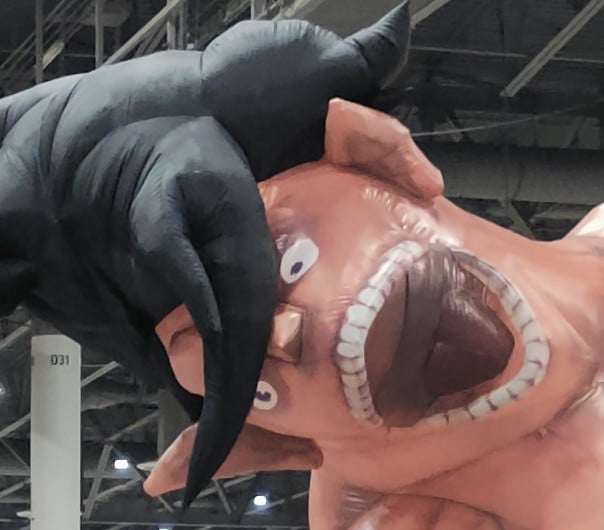Most domesticated bee species aren’t native to the US. It’s quite possible they are just getting bee-ported.
I don’t like this meme
I know it’s likely pesticides, but have we officially ruled out bee assassins?
Idk, I heard that trans people and immigrants are murdering bees.
You mean wasps? They have been pretty quiet lately…
Ah cmon now, stop spreading conspiracy theories. They probably just couldn’t prove citizenship and were deported.
All those darn African killer bees! Stealing all the jobs!
Isn’t pesticides just bee assassination on a mass scale? Thus, I argue, we cannot not yet rule that out.
i personally just think the bees are sentient and have depression
Probably the same reason we had 40+ tornadoes, huge hailstorms, floods, and drought-enabled wildfires in six adjacent states within 48 hours. Anthropogenic climate change is real, whether you believe in it or not.
my mother just told me as to we shouldn’t take climate change that serious and look into the 5-10 biggest sectors that affect it: “we just dont know what happens tomorrow, my child”
AHHAHAAHAHAHAH I have no hope, this person wasnt even unreasonable before. 2025 is so fucked, with a definite
Slap her in the face for me.
Dont forget that time the hurricane hit Tennessee and it fucking flooded the mountains
Everything is totally normal
Well, one would expect mountainous areas to flood because elevation focuses water flow. I’m in Florida, flattest state in the union. We never flood except in hurricanes, and those floods don’t last like they do in other places, in and out.
Still… I expect hurricanes in Florida, not in Tennessee.
Hurricanes are known to travel in land and up North though. The fact a hurricane hit Tennessee isn’t odd. It was the strength and the length it lingered over the state that made it devastating.
Anthropogenic climate change is real, whether you believe in it or not.
You know who believes in climate change? Fossil fuel companies, insurance companies, the military industrial complex, and every single politician talking about buying or taking Greenland by force. All the very same people who have spent the past half century publicly denying the existence of anthropogenic climate change. Not only do they believe in it, but they are designing their profit models around it at our expense.
Please stop saying sacreligious comments like this. It’s offensive to religious people.
The running thought is these non-native European honeybees couldn’t find forage at the right times due to climate change and these massive commercial hives died. That’s why introduced species as a monoculture don’t work out so well.
Okay, but European honeybees in the US aren’t exactly new afaik. That would be like if all of the sudden, 80% of wild horses up and die and the answer is “well, they’re an introduced species, so it only makes sense”.
Have you tried persecuting all the scientists yet??
They just got fired, together with anyone who might begin to fix this.
And the US government banned words related to climate change from any future studies. If your grant proposal includes those keywords, it’ll get denied automatically without a human even looking at it.
Refer to Ambience Adjustments in your research proposal?

Remember that honey-producing bees are terrible pollenators compared to the specific pollenators who don’t produce honey. The honey producing bees being kept by everyone are artifically outcompeting the specific pollenators, which are what we really need to be supporting.
Okay, but how do I personally monetize non-honey making bees? Sure, the general ecology needs this, but what’s in it for me, right this instant?
A bee petting zoo! Bumblebees are very cute and very fluffy. Having a petting zoo would help people get I touch with nature, and if the guests are too belligerent about it then the bees will just sting them. I think that bumblebees might also not die after stinging, and if so they’d learn how to fight humans. When the time is right you can unleash a swarm of cute fluffy bees trained in anti-human warfare. You could use them to crush any competition. If you still want more money you can become a bee-based supervillain and rob banks or something.
Hey, it doesn’t need to be right this instant. It could instead be projected revenue next quarter.
All you can do is add to pollen I guess. Plant seeds of native plants that bees love. Indiscriminately in random places.
Maybe someone else has some better ideas.
Tear out the lawn and re-wild the yard? Wild flowers, clover, etc. Less watering and mowing, and not just bees will love it - all kinds of insects and wildlife from birds to deer.
Those bees sure have plenty of legs for plenty of bootstraps
I was watching some of my native plants and noticed a fair amount of house flies crawling on them. So, I looked it up. It turns out that flies as a group are the second most important pollinator behind bees as a group.
make sure you retract words like bias and gender from your articles and they will come back. they are just extremely bigoted.
deleted by creator
nice one!
I’m not a bee, you’re not a bee, so it sounds like a them problem.
(On the internet, nobody knows you’re a bee.)
You can say whatever you want about them in text. As long as you don’t dance it, they’ll be none the wiser.
Bees aren’t the only arthropods having this problem, but for most of the other non-pollinators people seem to think "good less bugs to bother me. " I guess we should just give up on the survival of the food chain.
The news for insects is not entirely bad, emerald ash borers are finding the ability to survive in areas that were formerly too cold for them. This allows them to kill more trees turning them into kindling for lightning strikes and other fire starting events.
Who could have known that fucking with our habitat might have negative consequences for us?
The news for insects is not entirely bad, emerald ash borers are finding the ability to survive in areas that were formerly too cold for them. This allows them to kill more trees turning them into kindling for lightning strikes and other fire starting events.
Had me in the first half, not gonna lie.
hello frog, that is sad to hear, have you tried calling doompost?
(how is there no !doompost??)
In fairness, most of the news communities are doomposts by themselves.
Reality has a doom bias.
Best comment lmao
The people need their ads (or whatever the reasoning is), show some compassion, in a few decades they’ll only be seeing the same Nuka Cola ad everywhere.
I have a decently locked down browser and adblocker. The real page loads faster for me, takes no archive resources, and other have pointed out other benefits of preserving the canonical link as well.
Also, bees usually survive cold winters, which could be a thought for last few months.
Nowhere in the article does it say we lost 80% of the bee population. You are spreading misinformation
You’re correct. The quote is "If we lose 80% of our bees every year, the industry cannot survive, which means we cannot pollinate at the scale that we need to produce food in the United States."
It does, in a quote.
Not on the current scenario.
Honey bees are dying but you can help native bees in your area. Find out what they like and plant that shit. Also just letting weeds grow helps a lot of species.
I get leafcutter bees at my place as well as a few other solitary species
Making bee hotels for solitary bees is child’s play. Take a chunk of wood, drill holes, hang in a tree.
Technical aspects:
- Don’t use pressure treated lumber, anything else is fine.
- Look up “solitary bee hotel” for your area to see what size holes to make for the locals. In any case, it’s going to be a variety of different sizes to cover all your bases. Doesn’t have to bee (heh) perfect.
- Make the holes, especially the edges, nice and smooth. They’re not dumb enough to nest their if the hole is raggedy and might jack up their wings.
That’s mostly it. You can research easily enough in an hour or less There’s a woman on YouTube that sells bee hotels and has solid advice for making your own. Wish I remembered her name. Anyone?
Damned satisfying when you find the holes plugged with wax! You have new tenants! Stupid easy and basically free.
CAVEAT: These things are single use. Chunk 'em out every season, or better, burn them. Keeps the mites out. Make another for free.
Weeds? I thought they were pests
Weeds aren’t really a thing. A weed is just a plant we don’t like.
weeds are to gardens like my house is to HOAs.
G
As long as you mow them it’s all good. Just having a yard with anything than just a monoculture grass is better.
I can’t do that! What about my nice green grass lawn? /s
My city will put a letter in my mailbox telling me to get rid of weeds and fine me $150 if I don’t. Rip
Ouch. I have been trying to plant native plants in our garden. Luckily I don’t have anything like that in my city.
How do they enforce that? HOA?
No, the city rolls around and if there are things sticking up out of the ground high enough outside of a flower bed they take pictures and send you a letter
Cities have a lot of soft power in that regard. Mine, just as an example, bans parking on grass. Even if you’re not in a fancy neighborhood, and have been parking on your lawn underneath the spreading oak tree for the last 50 years, they can ticket you for it (and tow) if they feel like being ornery.
I think the usual wording for grass/plants goes along the lines of property values and nuisances to bring it within legal frameworks for what they can regulate.
The actual city sends a fine. If you don’t clean it, they send a crew. If you don’t pay for the crew, they lien the property.
Source: got letter from the city a week ago.
In fairness, I’ve been dealing with a lot and there were some areas that looked like we were abandoned. I’ve been meaning to clean out the unwanted stuff so the flowers can grow. My lawn is mostly moss and clover and that’s not what they cared about.















